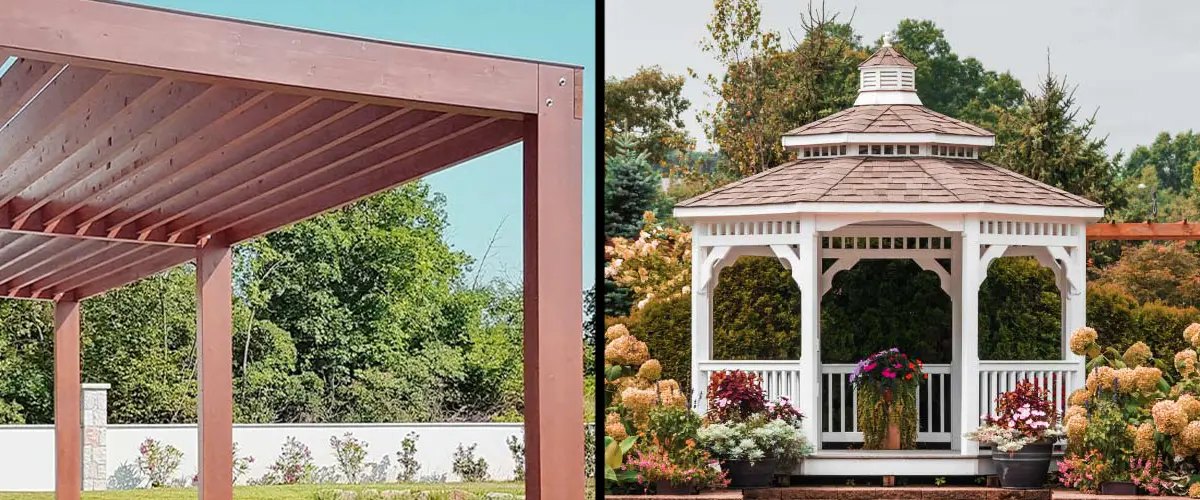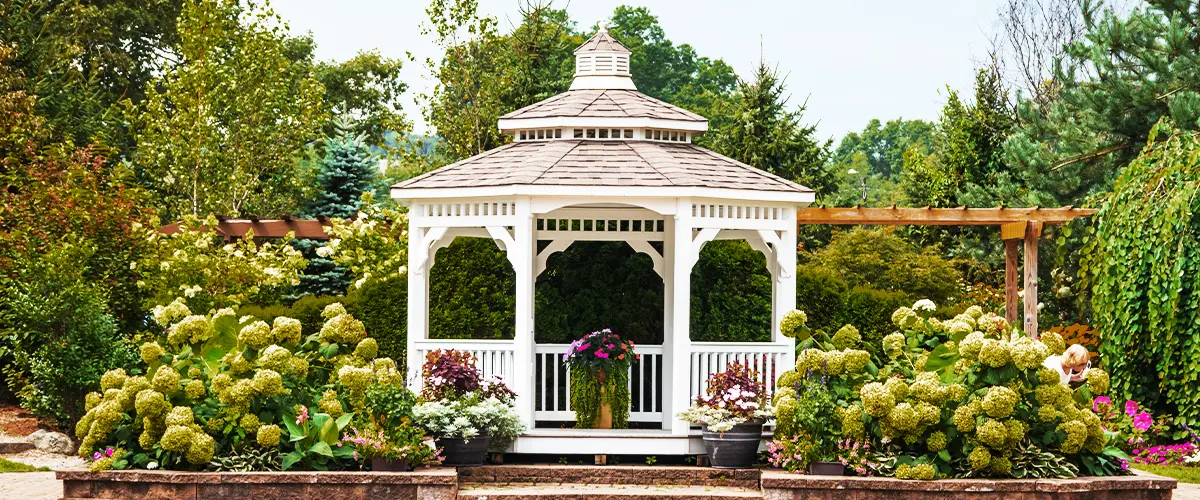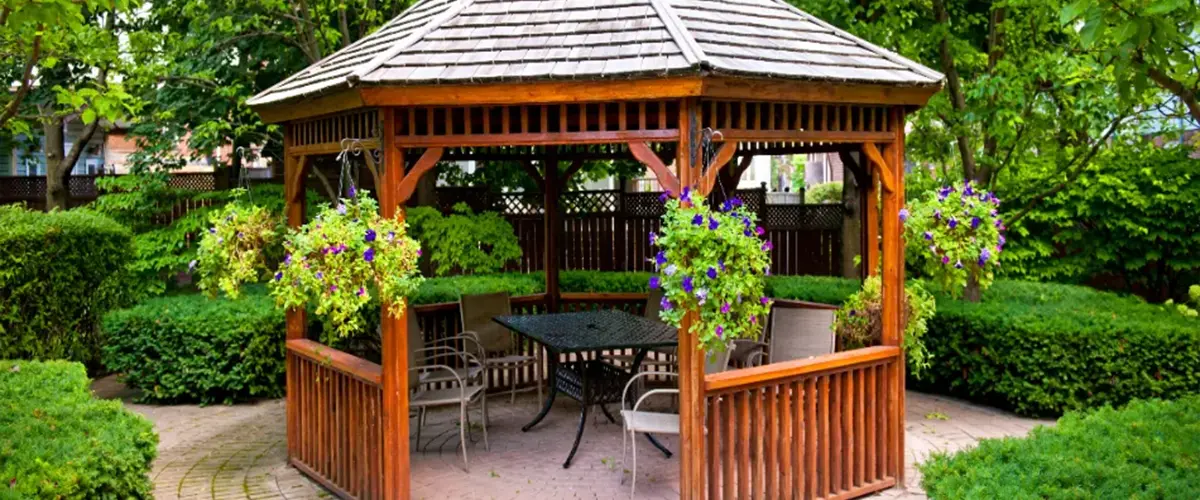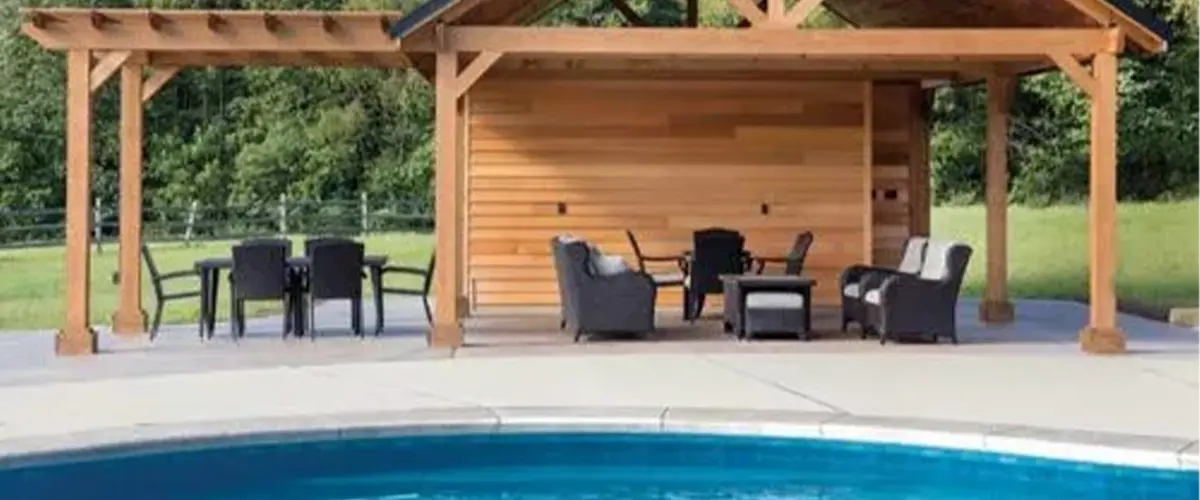If you want to add a shade structure in your outdoor space, the most popular upgrades here in Bryan, OH, are pergolas and gazebos.
But which is better?
In a nutshell, pergolas are great to add on a patio or a deck, whereas a gazebo works great in a landscape or a garden.
However, we’ve seen both of these work great in various settings. Let’s see where does the pergola vs gazebo debate takes us.

Differences Between Pergolas and Gazebos
Knowing the key differences between pergolas and gazebos is crucial for choosing the right structure to fit your Bryan, OH, landscape. Consider their purpose, visual appeal, and installation processes that can transform your outdoor space.
Pros And Cons Of Pergolas
| Pros Of Pergolas | Cons Of Pergolas |
|---|---|
| Aesthetic Enhancement: Pergolas add elegance and style to outdoor spaces, boosting overall aesthetics. | Limited Weather Protection: Offers partial shade but does not provide full shelter from rain or harsh weather. |
| Outdoor Living: These freestanding structures create an additional outdoor living area for dining, entertaining, or relaxation. | Maintenance: May require regular maintenance, especially for wood, which may need staining or sealing. |
| Versatility: Customizable to suit different styles and preferences, either standalone or attached to buildings. | Cost: The cost of installation can be relatively high, considering materials and professional labor. |
| Supports Plants: Provides a framework for climbing plants, adding greenery and a natural atmosphere. | Installation Complexity: Building may be complex, potentially requiring professional installation. |
| Increased Property Value: Well-designed and well-maintained pergolas can potentially enhance the resale value of a property by improving its outdoor appeal. | Limited Privacy: Open sides mean limited privacy; additional features may be needed for screening. |

DIY vs Hiring a Professional
| DIY Installation | Professional Installation |
|---|---|
| Cost savings are often the most compelling reason for homeowners to take the DIY route. | Hiring a professional may come with a higher cost, but it includes expert craftsmanship. |
| Personal satisfaction from completing the project can be immense for those who are handy. | Peace of mind knowing the job is done right by experienced hands is invaluable. |
| Time commitment is substantial and requires patience and a flexible schedule. | Efficiency is key; professionals work promptly, ensuring a timely project completion. |
| Learning opportunities arise from hands-on experience with materials and techniques. | Quality assurance comes from hiring skilled laborers who are familiar with local building codes. |
| Potential for mistakes exists, which could lead to additional costs or need for repairs. | Warranty or guarantee on workmanship is often provided when a professional is involved. |
| Tools and equipment must be sourced, which can be challenging for some homeowners. | Contractors bring their own tools, ensuring the use of professional-grade equipment. |
| Permits can be confusing and time-consuming to obtain for those unfamiliar with the process. | Professionals typically handle permits and are versed in local regulations and requirements. |
Selecting between DIY and professional installation hinges on a balance of cost, expertise, time, and personal confidence in undertaking such a project. Homeowners should weigh these factors carefully before enhancing their outdoor living space.
Permits and Utilities
Deciding between DIY and hiring a professional for outdoor structure installation like pergolas or gazebos may affect obtaining permits and dealing with utilities. In Bryan, OH, paying attention to legal requirements and utility locations is crucial before adding any landscape feature.
-
Check Local Regulations
-
Apply for Permits
-
Await Approval
-
Consult Utility Companies
-
Schedule an Inspection
-
Respect Property Lines
-
Consider Future Access
-
Follow Safety Standards
Adhere strictly to safety norms set by authorities while constructing your landscape feature to guarantee compliance with city regulations.

Effect on Property Value
Opting for a pergola or gazebo can positively impact your property’s value. These outdoor structures catch the eye of potential buyers and may lead to a higher resale price.
A well-designed pergola offers an elegant space for relaxation and entertainment, appealing to real estate listings in Bryan, OH. Installing a sturdy gazebo adds luxury to your landscape, potentially boosting curb appeal and attracting those seeking unique garden designs.
Crafting these additions with quality materials enhances durability and overall aesthetics. Choose a wooden structure that blends with nature or modern materials with a longer lifespan and less maintenance. Both options are investments in your property’s marketability.
Homeowners prioritizing yard enhancement find that erecting a pergola or gazebo creates an inviting backyard retreat, increasing home value.
More to read: How To Create An Outdoor Living Space
How To Pick The Right Pergola For Your Outdoor Space
Pergola Installation Types
Pergola Installation Tips
When installing pergolas, make sure that you select the right location. Pergolas should be placed in an open area where they will receive plenty of sunlight.
Determine the size of your pergola. It should be proportional to the size of your yard and the amount of space you have available. Keep in mind that larger pergolas will require more support beams.
The most important part of the frame is the ledger board, which should be securely fastened to your house or another structure. If you’re not confident in your DIY abilities, it’s best to hire a professional to install the ledger board and other key structural components.
Pergola Features
Pergola Materials
How To Pick The Right Gazebo For Your Outdoor Space

Gazebo Installation Types
There are three main types of gazebo installations: surface-mounted, sunken, and elevated. Each is a stand-alone structure.
Surface-mounted gazebos are the most common and can be installed on any level surface, including grass, concrete, pavers, or decking.
Sunken gazebos are installed into the ground and level with the surrounding ground surface.
Elevated gazebos are built on a raised platform, such as a deck or patio.
Gazebo Installation Tips
Gazebo Design Types
Patio Gazebo
Patio gazebos are usually made from wood or metal, and they can be attached to your deck or patio, or they can be a freestanding structure.
Pop-Up Gazebo
Pop-up gazebos are usually made from polyester or nylon, and they have a frame that collapses down for easy storage. They’re a good option if you want something that you can take with you on camping trips or picnics.
Grill Gazebo
Grill gazebos are designed to protect your grill from the elements, and they usually have shelves or hooks where you can store grilling tools and supplies. Many grill gazebos also come with built-in lighting, so you can keep grilling even after the sun goes down.
Gazebo Features
While the features of a gazebo can vary depending on its style and purpose, there are certain elements that are common to most gazebos.
Most gazebos have a roof, which can be made from a variety of materials such as thatch, shingles, or even metal. The roof is supported by columns or posts, which can be made from wood, stone, or brick.
Gazebos also typically have a floor, which may be made from decking material, landscape pavers, or concrete. Many gazebos also include features such as railings or latticework to further enhance their aesthetic appeal.
Gazebo Materials
The material of your selected gazebo will largely depend on its intended use. If you’re looking for a temporary structure, then materials like canvas or nylon would be better suited as they can be taken down and stored away easily. If you want a more permanent gazebo structure, opt for materials like wood or metal.
You can also find composite materials which offer the benefits of both wood and metal, such as durability and easy maintenance.
FAQs
Conclusion
Choosing between a pergola and gazebo for your Bryan, OH, backyard space depends on cost, durability, sunlight exposure, and shade preferences.
Each structure adds charm and value to your home, enhancing outdoor living spaces and creating an outdoor oasis that complements modern architecture.
- If you have a patio and love spending time outdoors, hosting family gatherings and barbecues, a pergola might be a better option.
- If you love spending time outdoors, but alone, gazebos are great for drinking coffee in the morning or reading a good book in the afternoon - undisturbed by anyone.
Regardless of what’s your preferred choice, here at Farrell’s Lawn And Garden Center, we’ve installed dozens of pergolas and gazebos. If you want a quality gazebo or pergola installation from an expert that puts you first, get a free quote from our website and we’ll call you back as soon as possible.
